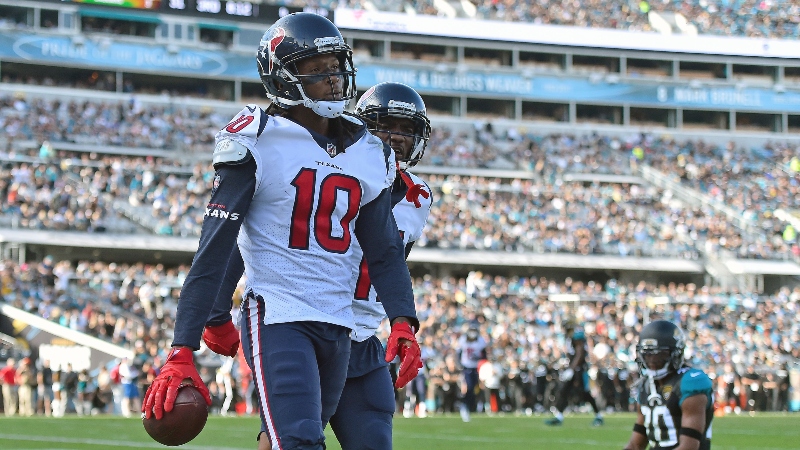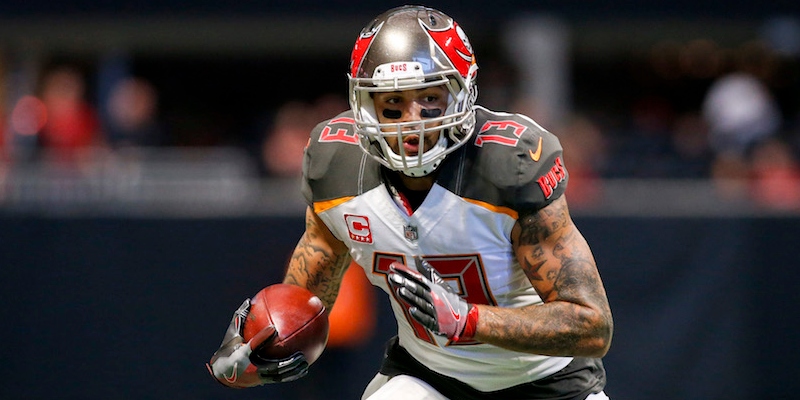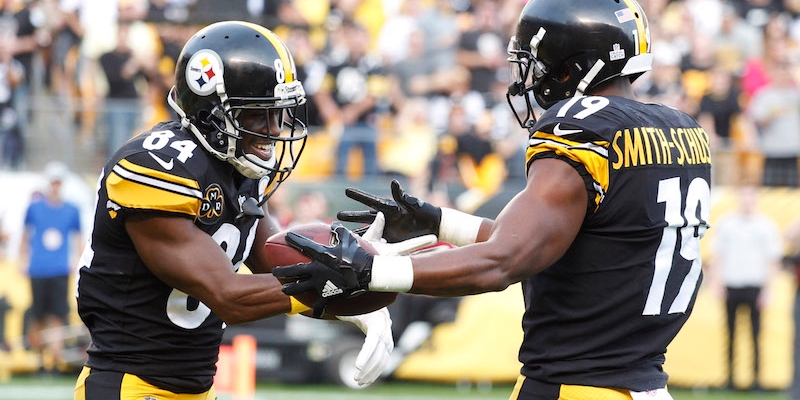In Week 13, I suggested that Steelers wide receiver Antonio Brown is falling off a cliff — and then he went off for a 10-154-1 receiving performance against the Chargers as a home favorite on Sunday Night Football.
In retrospect, my timing wasn’t great. The extent to which I was trolled on Twitter was nothing short of delicious. I must’ve looked like a flammable third-string cornerback with all my backpedaling.
In the burnt aftermath of Antonio’s season-best performance, I spent a significant amount of time on three podcasts talking about, defending and atoning for my #hottaek.
- The Taekcast with Davis Mattek
- RotoViz Radio with Dave Caban
- The Action Network NFL Podcast with Chris Raybon
And then, in Week 14, the Antonio short sellers got a big win.
Truly inspired by the way 30-year-old WR Antonio Brown carried the Steelers offense with his 5-35-0 performance in a 24-21 loss to the league-worst Raiders and their league-worst pass defense. https://t.co/5W0WmESabX
— Matthew Freedman (@MattFtheOracle) December 10, 2018
Do I actually think that Antonio is falling off a (metaphorical) cliff? Yes and no.
Antonio Brown Looks Slower
I don’t put a lot of stock in #TeamWatchTheTape. That’s not to say I don’t watch games or respect people who break down film, but it’s too easy for people who don’t watch tape in a systematic way to be led astray by their biases.
I’m not a tape-grinding expert, but to my untrained eye, Brown this year has looked slower, which would make sense: He’s 30 years old.
And he was never particularly fast to begin with. At the 2010 combine, he ran the 40-yard dash in 4.57 seconds, which is slow for a guy who is 5-foot-10 and 186 pounds. He displayed good agility with his 6.98-second three-cone drill — and his quick-twitch ability has been evident for years in his fantastic route-running — but Brown’s athleticism (I believe) is starting to go.
If you see something different when you watch the tape, that’s fine — and that’s why I usually don’t talk about what’s on the tape: It’s too subjective. We can always disagree on what numbers mean, but we can’t disagree on what the numbers are. With tape, there’s less uncertainty.
But for what it’s worth, regardless of whether Brown has lost some of his physical dynamism, Pro Football Focus through Week 14 has graded this season as Brown’s worst ever as a receiver on a 0-100 scale.
- 2018: 74.8
- 2017: 91.3
- 2016: 89.0
- 2015: 92.6
- 2014: 91.2
- 2013: 90.0
- 2012: 80.5
- 2011: 87.7
- 2010: 82.0
You can disagree with PFF’s methodology, accuracy, etc., but PFF breaks down each play systematically and grades it in a way that accounts for a variety of factors, including quarterback, scheme and defense.
I’m not the only one saying that Brown has significantly declined this year. With its grading system, PFF is also saying that Brown isn’t one of 2018’s best wide receivers.
The best wide receivers in the NFL in 2018. pic.twitter.com/PrvtFn3h50
— Pro Football Focus (@PFF) December 11, 2018
And regardless of who you are or whatever you’ve seen when you’ve watched Brown play this year, you’re probably not as good as PFF is at breaking down film.
Antonio Brown Is Having His Worst Season Ever
From a fantasy perspective, Brown is having a fine season. He’s tied for the position lead with 12 receiving touchdowns, and Brown is the No. 6 fantasy wide receiver overall with 276.3 DraftKings points.
He, of course, hasn’t fallen off a cliff.
But that’s the kind of thing you have to say if you want to wake people up from their stupor so they can see the warning signs for themselves.
Entering Week 15, Brown is second in the league with 142 targets. He trails Julio Jones for the league lead by just two targets. And yet Brown is tied for 11th with 86 receptions. He’s 12th with 1,063 yards receiving.
If not for his NFL-high 18 end-zone targets, the common perception on Brown this year would be very different, especially considering that he was a first-round pick in redraft leagues and has regularly had a top-three daily fantasy salary among wide receivers.
Granted, Brown is getting his targets, especially the high-leverage end-zone targets, because he’s a good player with an outstanding record of success. At the same time, the Steelers are prisoners of circumstance: They must give him valuable targets, because if they don’t, they are at risk of having an unhappy Antonio on their hands, and that would likely have negative repercussions in the locker room and on the field.
Brown is still a good player, but based on a variety of metrics, he is in marked decline. In 2014, Brown peaked in the first of his All-Pro campaigns. Since then, the falloff has been gradual but undeniable except by the most obstinate of Antonio truthers.

Credit: Charles LeClaire-USA TODAY Sports
Are there some circumstances that might explain and maybe excuse Brown’s decline? Sure, but those explanations might not be factual, they might not be as relevant as people think, they might not be any less likely to exist in the future and they definitely don’t make the present decline in production any less real.
Let’s look at just two efficiency metrics: RACR created by Josh Hermsmeyer and reFPOEPA (Receiving Fantasy Points Over Expectation per Attempt) created by RotoViz (accessible within the RotoViz Screener). RACR measures how effective a receiver is at transforming targets and air yards into receptions, yards after the catch and ultimately receiving yards. Similarly, reFPOEPA measures how effective a receiver is at turning targets into fantasy points relative to historical expectations based on the line of scrimmage.
- 2014: 0.91 RACR, 0.44 reFPOEPA
- 2015: 0.86 RACR, 0.35 reFPOEPA
- 2016: 0.80 RACR, 0.30 reFPOEPA
- 2017: 0.70 RACR, 0.32 reFPOEPA
- 2018: 0.69 RACR, 0.20 reFPOEPA
Given Antonio’s five-year efficiency trend, is it reasonable to expect that he won’t be even less efficient next year? And is it reasonable to expect that his declining efficiency won’t eventually result in fewer targets and touchdowns?
Antonio Brown’s Average Depth of Target & Quarterback Ben Roethlisberger’s Accuracy
On Twitter, many people who have disagreed with my Antonio take have made a couple of arguments.
- He’s being targeted downfield more often this year, so his increased inefficiency should be expected.
- Quarterback Ben Roethlisberger has been more inaccurate this year when throwing deep.
Let’s consider these points. Last year, Brown had a 13.5-yard average depth of target (aDOT). This year, he has a 10.9 aDOT. The numbers suggest that he’s not more of a deep receiver than he has been in the past.
In fact, his 2018 aDOT is very much in line with what we saw out of him before 2017.
- 2014: 10.3 aDOT
- 2015: 11.0 aDOT
- 2016: 10.4 aDOT
Brown is seemingly being used as he’s always been used.
On top of that, this year he’s actually been MORE efficient (compared to league-average expectations) on his deep targets than he has been closer to the line of scrimmage. Before this year, Brown had above-average efficiency until roughly 30 yards downfield.

This year, however, we’re seeing almost the exact opposite. Brown has been an above-average RACR receiver on only his deep targets.

Whatever Brown’s problems are, they don’t seem to be the result of his downfield usage. If anything, the numbers suggest that the Steelers should give him more deep targets, especially since Roethlisberger is pretty much the same passer he was last year.
Although Brown leads all wide receivers with 47 uncatchable targets (per PFF), the fact is that Roethlisberger’s year-to-year accuracy from 2017 to 2018 hasn’t diminished at all.
- 2017: 72.2% accuracy rate (19th), 31.8% deep accuracy rate (21st)
- 2018: 74.0% accuracy rate (23rd), 35.4% deep accuracy rate (21st)
Roethlisberger is an inaccurate passer, especially on passes of 20-plus yards, but he’s no more inaccurate now than he was last year.
Some of Brown’s issues are probably tied to Roethlisberger — but Brown truthers can’t have it both ways. Roethlisberger is better than backup quarterback Joshua Dobbs, right? By the way, Dobbs has attempted just 12 passes this year. When targeting Brown, he’s 2-of-3 passing for three yards and an interception.
Would the Brown truthers rather have a Steelers quarterback other than Roethlisberger throw Brown the ball? Or would they rather have Roethlisberger throw the ball to another Steelers wide receiver? — because if you watch the highlights from Week 14, it’s easy to reach the conclusion that Roethlisberger and even Dobbs looked at least adequate when throwing the ball to wide receiver JuJu Smith-Schuster, who went off for 8-130-2 receiving on 12 targets.
With 11 fewer targets this year and 528 fewer air yards, JuJu has five more receptions, 171 more yards receiving and 166 more yards after the catch. His 1.14 RACR stands in stark contrast to Brown’s 0.66 mark.
JuJu sees advantageous matchups in the slot, where he’s run 65.6% of his routes this year, and he doubtlessly benefits from Brown’s presence — but he also provides Brown with the best counterpart of his career. With JuJu on the field, defensive backs should be giving Brown less attention than they have at any other time in the past half decade.
And yet Brown’s been more inefficient than ever before.
Here’s the truth: 2007-08 Marvin Harrison and 2013-15 Roddy White are well within the range of outcomes for 2019 Antonio.
JuJu isn’t just the future. He’s arguably already the No. 1 wide receiver on the Steelers.
Passing the torch? #steelers
Antonio Brown’s last 6 games:
62 targets
Results: 40/511/4JuJu Smith-Schuster’s last 6:
62 targets
Results: 45/640/4
Cc: @MattFtheOracle
— Evan Silva (@evansilva) December 12, 2018
Is Antonio Brown Falling Off a Cliff?
No, not yet, but he’s on the edge of the cliff, and a numberless hoard of Antonio truthers act as if he’s not at all in a precarious situation. He might continue to stand on that precipice for years — or he might lose his balance and tumble over at any moment.
As Hector says of Helen of Troy in Shakespeare’s Troilus and Cressida, “Brother, she is not worth what she doth cost.”
And I say that as someone who loves Antonio.
He’s been a joy to watch for the past five years. He was such an underrated and multi-faceted college player. He had 1,000 scrimmage yards in each of his three seasons at Central Michigan, and he contributed steadily as a receiver, runner and returner. As a junior, he distinguished himself as one of just three FBS wide receivers over the past 20 years to have 1,500 scrimmage yards and to score as a receiver, runner and kick and punt returner. Brown dominated not through sheer physicality but nuanced technique and a diverse skill set.
In a sport of gladiators, he has been a wizard.

Credit: Charles LeClaire-USA TODAY Sports
That he’s become one of the best wide receivers of all time as a sixth-round draft pick is incredibly inspiring. He wasn’t supposed to be a No. 1 wide receiver. That wasn’t the Steelers’ intention for him. He was simply the team’s backup plan to wide receiver Emmanuel Sanders, who was selected three rounds ahead of him in 2010.
I say this with no irony: One of my biggest regrets of the past decade is dropping Brown in my longtime dynasty league the offseason after his rookie year.
Brown’s not falling off a cliff yet — but he’s no longer a top-10 wide receiver.
10 Wide Receivers Who Are Better Than Antonio Brown Right Now
If we look at expert dynasty leagues, we can see the extent to which the market for Brown’s future production has shrunk.
November’s DLF dynasty ADP marked the first time since August, 2014 that WR Antonio Brown was not in the 1st round.
CC: @MattFtheOracle
— Ryan McDowell (@RyanMc23) December 3, 2018
And his present intrinsic value I believe places him outside the top 10 at his position.
At The Action Network, we have 2018 NFL Power Rankings created by Sean Koerner, our Director of Predictive Analytics. Shooting from the hip, if I had to come up with wide receiver power rankings representative of what I think about the position at this moment, Brown would not be in the top 10.
Here are the players I would rank ahead of him, given his age and downward-trending inefficiency. (Team and age are in parentheses.)
1. Julio Jones (Falcons, 29)
Jones is No. 1 in NFL history with 97.1 yards receiving per game. Since breaking out in 2012 as a second-year Pro-Bowler, Jones has averaged 100.3 yards receiving per game. For each of the past four years, he’s led all wide receivers in yards per route run (per PFF).
- 2018: 2.90
- 2017: 3.08
- 2016: 3.12
- 2015: 3.04
Julio doesn’t score often, but touchdown production is pretty fluky for wide receivers. For my money, he’s still the best receiver in the league.
2. Tyreek Hill (Chiefs, 24)
In 13 games this year, Hill has 1,382 yards from scrimmage and 12 all-purpose touchdowns. He can score on any play thanks to his speed (4.29-second 40) and agility (6.53-second three-cone), and he’s getting extra opportunities almost every game as a runner and returner. Hill leads the league with 15.4 yards per touch.
With quarterback Patrick Mahomes throwing him the ball, Hill’s arrow is pointing up. He’s the modern-day version of 2005 Steve Smith.
3. DeAndre Hopkins (Texans, 26)
Nuk put up 4,487 yards in his first four seasons despite the indignity of having to catch passes from the malignant nonet of Matt Schaub, Case Keenum, T.J. Yates, Ryan Fitzpatrick, Ryan Mallett, Tom Savage, Brian Hoyer, Brandon Weeden and Brock Osweiler. And over the past two seasons, he’s been just as productive as a point-per-reception (PPR) receiver without quarterback Deshaun Watson as with him (per the RotoViz Game Splits App).
- With Watson (20 games): 20 PPR points, 10 targets, 6.5 receptions, 87.9 yards, 0.8 touchdowns
- Without Watson (eight games): 20.5 PPR points, 12.3 targets, 6.4 receptions, 96.5 yards, 0.75 touchdowns
In comparison, Brown hasn’t been anything close to his usual self over the past five years without Roethlisberger.
- With Roethlisberger (69 games): 22.9 PPR points, 11.5 targets, 7.7 receptions, 102.6 yards, 0.81 touchdowns
- Without Roethlisberger (five games): 12 PPR points, 8.4 targets, 4.8 receptions, 68.3 yards, zero touchdowns
For as good as he’s been, Antonio hasn’t proven himself to be a quarterback-proof receiver. Nuk has.

Credit: Jasen Vinlove-USA TODAY Sports. Pictured: Houston Texans wide receiver DeAndre Hopkins (10).
4. Odell Beckham Jr. (Giants, 26)
In his first three seasons, OBJ became one of just three players in NFL history to open his career with three 1,000-yard, 10-touchdown receiving campaigns — and he did that with the corpse of quarterback Eli Manning. Still very much in his physical prime, Beckham has an NFL-high 390 receptions through his first 59 games played.
5. Michael Thomas (Saints, 25)
Since his 2016 rookie season, Thomas leads the league with 298 receptions on 388 targets. For comparison: In that span, Brown is second with 293 receptions on a whopping 459 targets. No player in NFL history has more receptions in his first three seasons than Thomas does with 298 — and he still has three more games left this year.
6. Davante Adams (Packers, 26)
Adams had a slow start to his career, but over the past three seasons he’s averaged more than 1,000 yards and 10 touchdowns per year. He’s been especially dominant as a scorer: He leads the league since 2016 with 34 receiving touchdowns, and he’s the only player with 10-plus receiving touchdowns in each of the past three years.
While he’s fortunate to have quarterback Aaron Rodgers throwing him the ball, Adams has managed to maintain his productivity over the past few seasons even when Rodgers has been out.
- With Rodgers (36 games): 17.8 PPR points, 8.8 targets, 5.6 receptions, 71.9 yards, 0.83 touchdowns
- Without Rodgers (seven games): 16.3 PPR points, 8.9 targets, 5.9 receptions, 69.9 yards, 0.57 touchdowns
If the Packers find an innovative play-caller to guide the offense, Adams could jump into the top four. Whoever they hire isn’t likely to be worse than former head coach Mike McCarthy.
7. Mike Evans (Buccaneers, 25)
Evans isn’t the most efficient wide receiver (54.9% catch rate), and he’s a little Julio-esque as a scorer (just 10 touchdowns over the past two years), but he has an outstanding biophysical profile (6-foot-5, 231 pounds, 4.53-second 40), and he’s only the third player in NFL history with 1,000 yards receiving in each of his first five seasons.
The other two players are Randy Moss (1998-2002) and A.J. Green (2011-15).

Credit: Brett Davis-USA TODAY Sports
8. Amari Cooper (Cowboys, 24)
In NFL history, only three wide receivers to play as 21-year-old rookies have had 1,000 yards receiving in each of their first two seasons: Moss, Evans and Cooper. His 2017 season was derailed by the overall incompetence of HC Jack Del Rio and offensive coordinator Todd Downing and a debilitating back injury to quarterback Derek Carr, but since his midseason trade to the Cowboys this year, Cooper has an NFL-high 642 yards and six touchdowns receiving on a mere 8.8 targets per game.
That he has integrated himself so well into an offense overseen by HC Jason Garrett and led by inconsistent quarterback Dak Prescott speaks to Cooper’s elite talent. He has a legitimate chance to be the NFL’s most productive wide receiver over the next five years.
9. Adam Thielen (Vikings, 28)
Thielen leads the league with 103 receptions, and he’s the No. 1 fantasy wide receiver right now with 24.0 DraftKings points per game. I’m somewhat dubious about his future prospects because of his age, his slot-centered role and the presence of his dynamic and younger teammate Stefon Diggs, but Thielen is wrapping up the best season of his career, and he’s gone over 1,200 yards in each of the past two years.
As the league’s premier high-volume middle-of-the-field wide receiver, Thielen seems likely to be comparably productive for at least one more year.
10. JuJu Smith-Schuster (Steelers, 22)
JuJu turned 22 years old on Thanksgiving. He is young, he has good size (6-foot-1, 215 pounds) and sufficient speed (4.54-second 40) and he set an NFL record with his 1,783 yards receiving before his 22nd birthday.
Brown didn’t even play an NFL snap before turning 22.
Since the Steelers’ Week 7 bye, Brown has 20.9 DraftKings points per game with a +1.62 Plus/Minus; JuJu, 21.5 and +5.04.
When a big play was needed at the end of the game in Week 14, the Steelers didn’t call for a lateral to Brown: They gave the ball to JuJu, who put them in position to tie with a field goal.
Brown has been great for the past five years. JuJu could be great for a decade.
And that decade’s already started.

Credit: Charles LeClaire-USA TODAY Sports
Honorable Mentions
Do I really think these eight wide receivers are better than Brown right now? Maybe.
11. Keenan Allen (Chargers, 26): Ranks fourth since 2015 with 85.7 yards per game
12. T.Y. Hilton (Colts, 29): Has averaged 89.0 yards across his 48 games with quarterback Andrew Luck since 2014
13. A.J. Green (Bengals, 30): Owns a 1,000-yard receiving campaign in each of his six healthy NFL seasons
14. Brandin Cooks (Rams, 25): Is one of only four players with 1,000 yards receiving in each of the past four years
15. Stefon Diggs (Vikings, 25): Will finally hit 1,000 yards receiving in his first season unencumbered with injuries
16. Kenny Golladay (Lions, 25): Gotta have dreams
17. Josh Gordon (Patriots, 27): Outsized dreams
18. D.J. Moore (Panthers, 21): Outrageous, unreal, hater-trolling dreams
Matthew Freedman is the Editor-in-Chief of FantasyLabs. He has a dog and sometimes a British accent. In Cedar Rapids, Iowa, he’s known only as The Labyrinthian.






